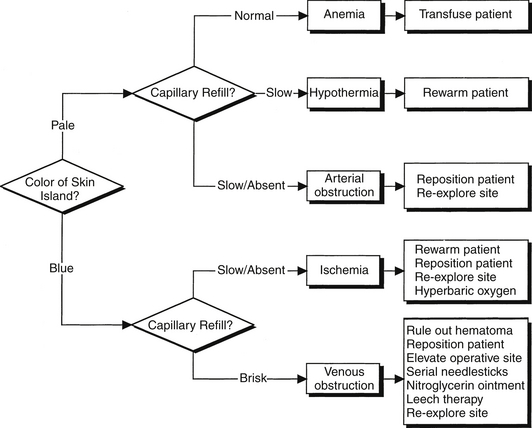Chapter 91
Major Tissue Flaps 
Complications of Flap Surgery
Both the recipient and the donor sites of flaps are subject to the problems of any operative wound, such as bleeding, hematoma, suture line dehiscence, infection, and localized edema (Table 91.1). Because many patients receive perioperative anticoagulation, hematoma formation is a distinct risk because flap “harvests” result in large raw surfaces at the donor site. ![]()
TABLE 91.1
Risk Factors for Flap Ischemia in the Immediate Postoperative Period
| Hematoma, Bleeding | Malpositioning of Patient |
| Donor site or sites | Increased tension on vascular pedicle |
| Recipient site | Compression of vascular pedicle |
| Anticoagulation-related | Increased dependent edema |
| Ischemia Caused by Arterial Obstruction | Potential pressure necrosis |
| Vasoconstriction, vasospasm | Other Generic Factors |
| Twisted or kinked pedicle | Anemia |
| Excessive traction | Edema |
| Thrombosed anastomosis | Infection |
| Ischemia Caused by Venous Obstruction | Hypothermia |
| Twisted or kinked pedicle | Hypovolemia with hypotension |
| Excessive traction | |
| Compression by hematoma or flap edema | |
| Thrombosed anastomosis |
Postoperative edema can severely compromise flap perfusion and stress suture lines. The operated site should be elevated above the level of the heart, if possible. The use of corticosteroids during flap harvest and early postoperatively to decrease flap edema remains controversial.
Flap Monitoring: Subjective Methods
Color
A skin flap or a skin island of a myocutaneous flap (Figure 91.1) should be the same color (or slightly more pink) as the adjacent skin from which it was harvested. If it is hyperemic and purple, however, the venous outflow may be occluded. If it is mottled or extremely pale, the arterial inflow may be compromised. Of note, skin color changes in darkly pigmented patients may be difficult to discern.

Figure 91.1 Schematic flow diagram for the evaluation and management of a threatened flap with a skin island visible.
Capillary Refill
It should normally take about 1 to 2 seconds for the color to return after manual blanching of the skin. Flaps with venous congestion show immediate refill, whereas flaps that are slow to fill may have compromised arterial inflow. Capillary refill may be difficult to assess in patients with darkly pigmented skin. Importantly, a skin graft normally has no capillary refill in the first 4 to 5 days after implantation as it takes this amount of time for vessels to grow and reperfuse the graft.
< div class='tao-gold-member'>

Full access? Get Clinical Tree



